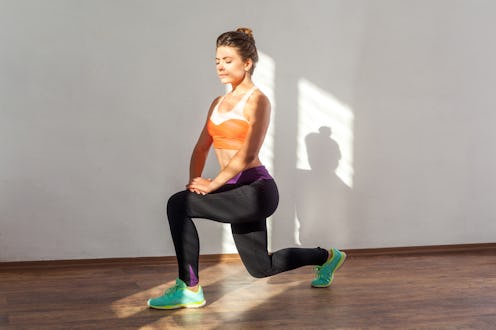
If you typically do regular air squats to work your glutes, consider picking up one foot, taking a big step forward, and doing split squats instead. This slightly different move works the glutes in a brand new way, and can really amp up your strength training game.
Though it’s called a split squat, it’s more of a lunge variation. “A split squat is essentially a stationary lunge,” says Kate Meier, a certified personal trainer with Garage Gym Reviews. “The feet do not move while the body lowers down into a lunge position and then stands up to the starting position.” But while lunges are a dynamic exercise that require movement, Macy Pruett, a certified personal trainer and owner of Fittest Core, says split squats are static and don’t require you to step out and back in again. And that’s partially why they bring a serious burn to your glute muscles.
Another benefit of split squats is that they’re a unilateral movement, which means they isolate one side of the body at a time. Compare that to regular squats, a bilateral exercise that requires you to use both legs and glute muscles at once. When your right leg is placed in front of you during a split squat, you only work the right leg and glute muscle, Pruett explains, which accounts for the targeted burn.
It’s key differences like these that set split squats apart from regular squats and lunges. It’s also why you might just want to add them to your routine, especially if you’re up for a challenge. Here, trainers share how to do a split squat with good form, plus all the benefits you can expect from working one side of your body at a time.
How To Do A Split Squat
To get the most benefit, it’s essential to do split squats the right way, which is why Meier recommends keeping an eye on the placement of your feet and knees. To do a split squat, start with your feet together, then step one foot forward so that your legs form a triangle.
Keep your torso straight as you bend both knees into 90-degree angles. Lower down until your back knee lightly taps the floor. As you raise back up to the starting position, think about pushing into your front heel and really squeezing the glute of your back leg, Meier says.
Split Squat Benefits
Remember, regular squats are bilateral and work both legs at once, while split squats are unilateral. While squats are still an effective exercise, there’s something to be said for working one leg at a time. During a split squat, the back leg gets put into extension, which fully contracts the glute of that leg, says Meier. That means you get to focus on each side of your booty at a time to ensure you’re getting a good workout.
Split squats also recruit your stabilizing muscles. “The staggered foot position makes the outer glute muscles have to work to balance and stabilize the body,” Meier adds. “The entire glute and hip area will effectively be worked, and without any compensation from the other side.” This is a good way to ensure you aren’t over-training one side of your body, and it helps prevent muscle imbalance.
You’re not just getting a great butt workout, though: According to Pruett, split squats also incorporate other lower body muscles, including the hip flexors, hamstrings, and quads. Training your lower body will help improve your overall balance and stability, too — all good things that come from taking a step forward from a regular squat.
How To Modify Split Squats
To make this move easier, Pruett suggests holding onto something for support, like a bar or a wall. With some added stability, you’ll be able to lower into the squat without tipping over. You should also feel free to only do a few reps at a time as you work on gaining strength.
To make the move more challenging, place your back foot on an elevated surface for a Bulgarian split squat. This extra tricky position will allow you to test your balance even more as you raise and lower your back knee, while also asking more of the muscles in your front leg.
You can also incorporate weights to increase the load, Meier says. Hold dumbbells by your sides, lift dumbbells up overhead with each rep, or place a barbell on your back to add a little extra resistance.
Mistakes To Avoid
According to Pruett, it’s essential to maintain a neutral spine throughout this move. You should also check to ensure your hips are squared up or facing forward, and that your torso remains upright. As you perform the exercise, keep checking to make sure your front knee stays in line with your front foot. You don’t want your knee to extend past your toes as you lower. If it does, take a bigger step forward.
Another common mistake is squatting while your feet are either too close together or too far apart. Check for that 90-degree angle when in the bottom of the move, Meier says, and you should be right on track to really work your glutes.
Studies referenced:
Aguilera-Castells, J. 2019. Muscle activity of Bulgarian squat. Effects of additional vibration, suspension and unstable surface. PloS one. https://doi.org/10.1371/journal.pone.0221710.
DeForest, B. (2014). Muscle Activity in Single- vs. Double-Leg Squats. Int J Exerc Sci. https://www.ncbi.nlm.nih.gov/pmc/articles/PMC4831851/
Schellenberg, F. (2017). Towards evidence based strength training: a comparison of muscle forces during deadlifts, goodmornings and split squats. BMC Sports Science, Medicine and Rehabilitation volume 9, Article number: 13.
Williams, M. (2021). Activation of the Gluteus Maximus During Performance of the Back Squat, Split Squat, and Barbell Hip Thrust and the Relationship With Maximal Sprinting. Journal of Strength and Conditioning Research. doi: 10.1519/JSC.0000000000002651
Sources:
Kate Meier, certified personal trainer with Garage Gym Reviews
Macy Pruett, certified personal trainer and owner of Fittest Core